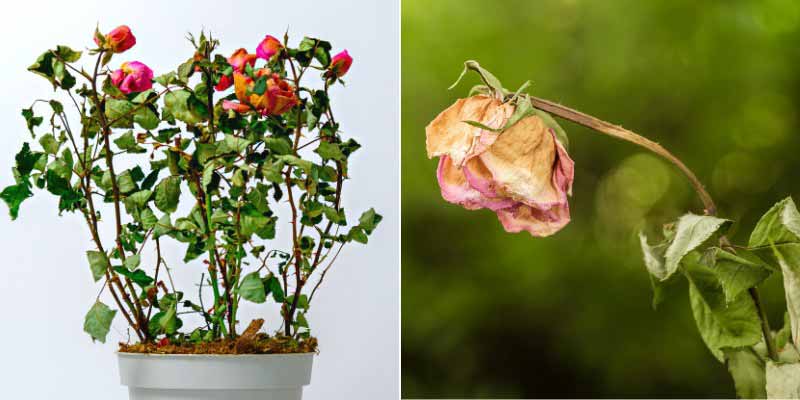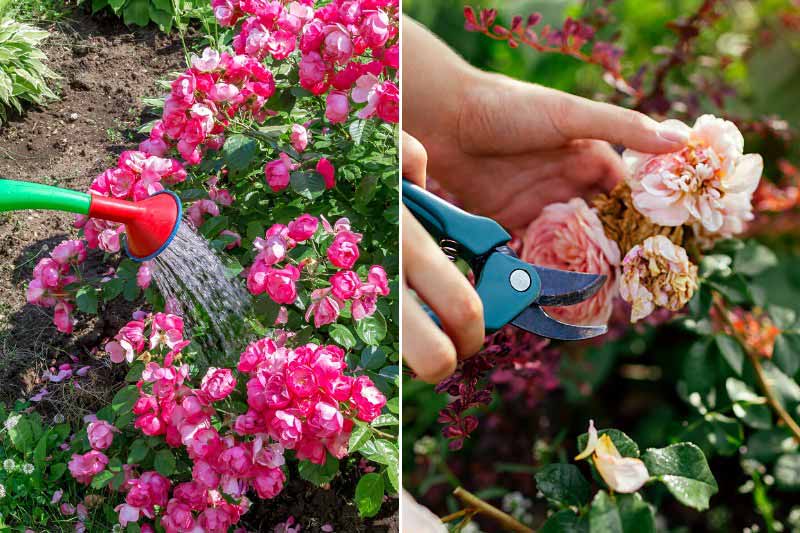With climate change, dry spells are becoming longer and earlier. Roses are not spared and sometimes suffer from this lack of water over an extended period, which can gradually lead to their decline if action is not taken in time. It is therefore important to manage watering well and implement certain techniques to protect roses. Discover how to recognise a thirsty rose and how to save it!
1 - What are the symptoms of water stress?
Not all plants react the same way to drought. Certain physiological reactions indicate that the plant is suffering from a lack of water. It is important to know how to recognise when a rose is thirsty, so you can respond quickly:
- The leaves wilt, droop towards the ground, and begin to yellow. They dry out and then detach and fall off. If nothing is done, the branches will gradually become bare.
- The young shoots also wilt. They may turn brown and stop growing.
- The flowers and flower buds will also dry out and turn brown. The flowers and the tops of the stems become soft and droop towards the ground.
- If nothing is done, the rose will gradually dry out, starting from the tips of the shoots: no longer supplied with water, they turn brown and brittle.
The lack of water can sometimes be confused with chlorosis: the foliage yellows, but between the veins, whereas in the case of drought, the foliage yellows uniformly. Similarly, the rose may be affected by root rot (a fungal disease), in which case it will dry out suddenly. However, it is clear that if your region is experiencing a heatwave or a dry spell, and other plants are showing signs of water stress, your rose is also suffering from this drought.

2 - Anticipating risk situations
Some situations make your rose more susceptible to drought. Here are a few of these risk situations:
- Heatwave: a prolonged period of intense heat can quickly dry out the soil and deprive your rose of the water it needs to survive.
- Container cultivation: potted roses are also at risk as the substrate dries out much more quickly than for roses in the ground.
- Recent planting: roses that have been recently planted have a less developed root system, making them more vulnerable to drought. It is therefore important to be vigilant and water regularly during the first year.
The best approach is to anticipate dry periods, by monitoring the weather and watering the garden accordingly. If you plan to be away, ask a neighbour to water your plants, or install an automatic watering system or oyas. Also, consider adding a layer of mulch around your plants, and shading the roses that are in full sun if possible. If your rose is in a pot, repotting it into a larger plastic pot rather than a terracotta one will help it withstand drought better.
Be aware that some roses are particularly well-suited to heat and drought. This includes, for example, the Banks rose, the 'Old Blush' rose, the chinensis 'Mutabilis' rose, as well as rugosa roses (Rosa rugosa).
3 - How to save a rose suffering from drought?
Now that you have identified the problem, let's move on to solutions. To protect your rose from heat and drought, here are some measures you can take:
- Water generously: Obviously, the most important thing is to water as soon as you realise your rose is thirsty! During periods of intense heat, increase the frequency of watering. We recommend watering early in the morning or late in the evening to minimise evaporation. Direct the stream at the base of the plant, avoiding wetting the foliage. Indeed, water droplets on the leaves create a "magnifying glass" effect, which can burn the plant by amplifying solar radiation. Additionally, this promotes fungal diseases.
Better to water generously than to water several times superficially. This way, the water penetrates deeper into the soil, encouraging the plant to develop deep roots, whereas with superficial watering, the water remains near the surface, and the soil dries out more quickly.
- Mulch: Mulching is an excellent way to retain soil moisture. Apply a good layer of organic mulch (at least 6 cm thick) around the base of your roses. You can use, for example, dead leaves, straw, wood chips, bark, or RCW (ramial chipped wood). Mulching also limits water runoff in case of heavy rain or if the ground is sloped.
- Prune: A light pruning can help your rose manage drought better. Remove burnt stems and dry or damaged leaves. This will allow the plant to conserve its energy.
- Remove faded flowers: Indeed, flowering, followed by fruit formation (hips), requires a lot of energy from the rose. Removing them allows it to focus on survival. For fully bloomed flowers that are not yet faded, in case of severe water stress, you can remove one out of two. It is indeed better to sacrifice part of the flowering to preserve the rose! This will help it recover.
- Shade: Prolonged exposure to sunlight during a heatwave can be particularly damaging to roses. You can protect them by installing shade cloths. The idea is to shelter them from direct sunlight at least during the hottest hours of the afternoon. If your roses are grown in pots or containers, simply move them to the shade.

Further reading
- Feel free to check out our articles: "Heatwave: 10 tips to protect your plants" and "Watering a garden during a heatwave"
- Our advice sheet: "Watering plants during or after a drought"
- "How to save garden plants after a drought?"































Comments